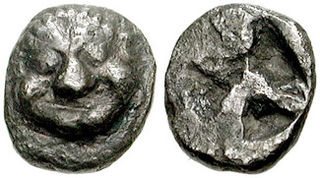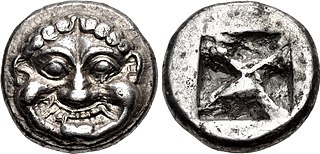
Aegina is one of the Saronic Islands of Greece in the Saronic Gulf, 27 km (17 mi) from Athens. Tradition derives the name from Aegina, the mother of the mythological hero Aeacus, who was born on the island and became its king.

Marathon is a town in Greece and the site of the Battle of Marathon in 490 BCE, in which the heavily outnumbered Athenian army defeated the Persians. Legend has it that Pheidippides, a Greek herald at the battle, was sent running from Marathon to Athens to announce the victory, which is how the marathon running race was conceived in modern times. Today it is part of East Attica regional unit, in the outskirts of Athens and a popular resort town and center of agriculture.

Attic Greek is the Greek dialect of the ancient region of Attica, including the polis of Athens. Often called classical Greek, it was the prestige dialect of the Greek world for centuries and remains the standard form of the language that is taught to students of ancient Greek. As the basis of the Hellenistic Koine, it is the most similar of the ancient dialects to later Greek. Attic is traditionally classified as a member or sister dialect of the Ionic branch.

The Solonian constitution was created by Solon in the early 6th century BC. At the time of Solon, the Athenian State was almost falling to pieces in consequence of dissensions between the parties into which the population was divided. Solon wanted to revise or abolish the older laws of Draco. He promulgated a code of laws embracing the whole of public and private life, the salutary effects of which lasted long after the end of his constitution.

Shekel or sheqel is an ancient Mesopotamian coin, usually of silver. A shekel was first a unit of weight—very roughly 11 grams —and became currency in ancient Tyre and Carthage and then in Hasmonean Judea.

The obol was a form of ancient Greek currency and weight.

The history of ancient Greek coinage can be divided into four periods: the Archaic, the Classical, the Hellenistic and the Roman. The Archaic period extends from the introduction of coinage to the Greek world during the 7th century BC until the Persian Wars in about 480 BC. The Classical period then began, and lasted until the conquests of Alexander the Great in about 330 BC, which began the Hellenistic period, extending until the Roman absorption of the Greek world in the 1st century BC. The Greek cities continued to produce their own coins for several more centuries under Roman rule. The coins produced during this period are called Roman provincial coins or Greek Imperial Coins.
The talent was a unit of weight used in the ancient world, often used for weighing gold and silver, but also mentioned in connection with other metals, ivory, and frankincense. In Homer's poems, it is always used of gold and is thought to have been quite a small weight of about 8.5 grams (0.30 oz), approximately the same as the later gold stater coin or Persian daric.

A span is the distance measured by a human hand, from the tip of the thumb to the tip of the little finger. In ancient times, a span was considered to be half a cubit. Sometimes the distinction is made between the great span or full span and little span or short span.
The Attic talent, also known as the Athenian talent or Greek talent, is an ancient unit of weight equal to about 26 kilograms (57 lb), as well as a unit of value equal to this amount of pure silver. A talent was originally intended to be the mass of water required to fill an amphora, about one cubic foot (28 L).
An amphora was the unit of measurement of volume in the Greco-Roman era. The term amphora comes from ancient Greece where people used a tall jar looking container with two opposed handles near the top mostly made of ceramic. Amphora literally means "two handled".
Quantitative metathesis is a specific form of metathesis or transposition involving quantity or vowel length. By this process, two vowels near each other – one long, one short – switch their lengths, so that the long one becomes short, and the short one becomes long.
Heliaia or Heliaea was the supreme court of ancient Athens. The view generally held among scholars is that the court drew its name from the ancient Greek verb ἡλιάζεσθαι, which means congregate. Another version is that the court took its name from the fact that the hearings were taking place outdoors, under the sun. Initially, this was the name of the place where the hearings were convoked, but later this appellation included the court as well.

In the theatre of ancient Greece, the choregos was a wealthy Athenian citizen who assumed the public duty, or choregiai, of financing the preparation for the chorus and other aspects of dramatic production that were not paid for by the government of the polis or city-state. Modern Anglicized forms of the word include choragus and choregus, with the accepted plurals being the Latin forms choregi and choragi. In Modern Greek, the word χορηγός is synonymous with the word "grantor".

The tetradrachm was a large silver coin that originated in Ancient Greece. It was nominally equivalent to four drachmae. Over time the tetradrachm effectively became the standard coin of the Antiquity, spreading well beyond the borders of the Greek World. As a result, tetradrachms were minted in vast quantities by various polities in many weight and fineness standards, though the Athens-derived Attic standard of about 17.2 grams was the most common.
A medimnos was an Ancient Greek unit of volume, which was generally used to measure dry food grain. In Attica, it was approximately equal to 51.84 litres, although this volume was frequently subject to regional variation. For example, the Spartan medimnos was approximately equal to 71.16 litres. A medimnos could be divided into several smaller units: the tritaios, the hekteus, the hemiektos, the choinix and the kotyle

Byzantine units of measurement were a combination and modification of the ancient Greek and Roman units of measurement used in the Byzantine Empire.

In ancient Greece, the drachma was an ancient currency unit issued by many city-states during a period of ten centuries, from the Archaic period throughout the Classical period, the Hellenistic period up to the Roman period. The ancient drachma originated in the Greece around the 6th century BC. The coin, usually made of silver or sometimes gold had its origins in a bartering system that referred to a drachma as a handful of wooden spits or arrows. The drachma was unique to each city state that minted them, and were sometimes circulated all over the Mediterranean. The coinage of Athens was considered to be the strongest and became the most popular.
Phalanx is a minor Attic figure in Greek mythology who features in a lesser-known narrative of the myth of Arachne, the girl who enraged the goddess Athena by boasting of being a better weaver than her and was thus transformed into a spider by Athena. In this version of the story, Phalanx is Arachne's brother, and they are both punished by the goddess when they break a societal taboo.















